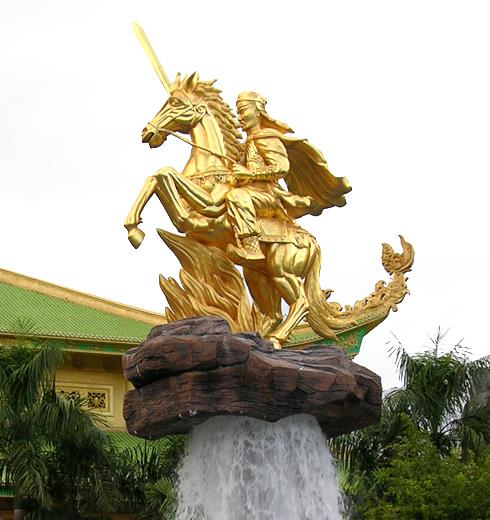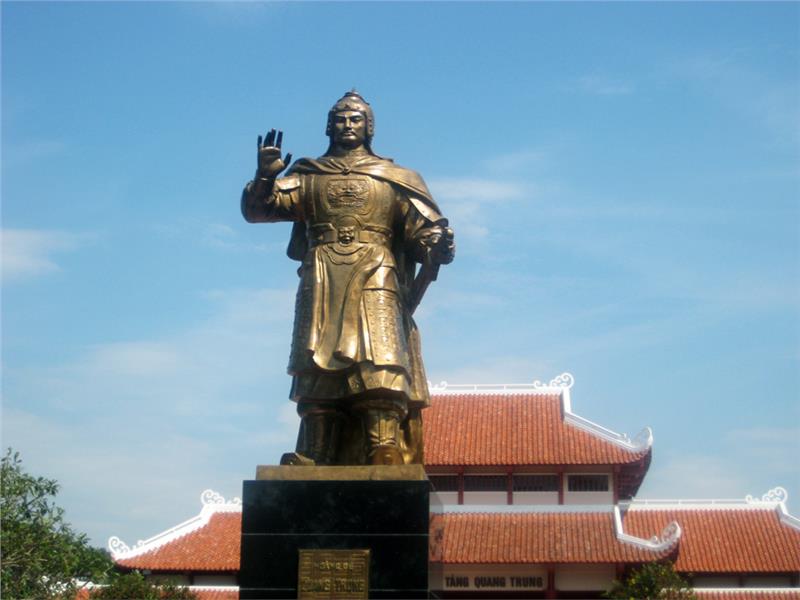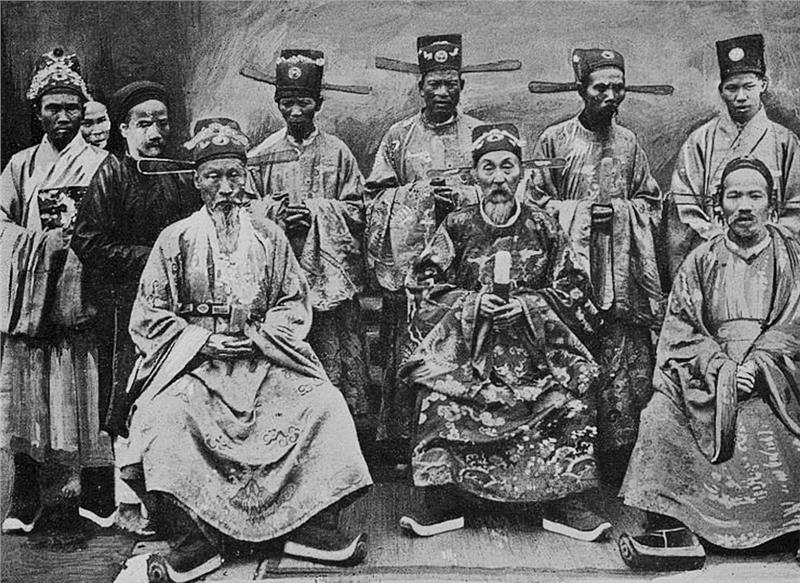The basic properties of Vietnamese society virtually remained unchanged for nearly 1000 years from the 10th century (escaping the domination of China) to the 19th century (French invasion). During this period, Vietnam was governed under the autonomous feudalism. After Ngo Quyen came to the throne, he ruled for a short time before his death that led to a struggle for power. This is the first great civil war in the country. There were serious fluctuations in the chaotic period of Vietnam history. The struggle is also known as Twelve Lords Disorders. The civil war lasted in 20 years (944-968), then, Dinh Bo Linh who defeated other warlords, and unified the country. He founded Dinh Dynasty, proclaimed himself a King named Dinh Tien Hoang (First Dinh Emperor). He renamed the country into Dai Co Viet (i.e. Great Viet Land), with the capital in Hoa Lu (Ninh Binh today).
In 979, Emperor Dinh Tien Hoang and his crown prince were murdered, leaving his 6-year-old son behind, Dinh Toan who after that assumed the throne. Taking advantage of the situation, Song Dynasty (China) invaded Dai Co Viet again. Facing a serious threat to national independence, Le Hoan came to the throne, and founded Prior Le Dynasty. He proclaimed Emperor Le Dai Hanh, as well as the first king of Vietnam who began the process of southward expansion against the kingdom of Champa. At the same time, Le Hoan also created prerequisite and condition for Ly Cong Uan (the founder of Ly Dynasty in 1009) to move the capital from Hoa Lu to Thang Long in 1010, opening a long-term development of the original culture of Thang long – Hanoi, present-day capital of Vietnam. In 1054, Ly Thanh Tong (third king of the Ly dynasty) changed the country's name into Dai Viet. Dai Viet underwent many Vietnamese dynasties of Ly Dynasty (1009-1225), Tran Dynasty (1226-1400), Ho Dynasty (1400-1407), Posterior Le Dynasty (1428-1527), Mac Dynasty (1527 -1592), Restored Le Dynasty (1533-1789), and Tay Son Dynasty( 1778-1802 ).

During this time, northern dynasties in China and Mongol invaded Vietnam, but they were expelled by Vietnamese such as Le Hoang and Ly Thuong Kiet who beat Song Dynasty (in 981 and 1076), Tran Dynasty defeated Mongol in 1258 and Yuan Dynasty in 1285 and 1288. In early 15th century, Ming Dynasty annexed Dai Viet and ruled for 20 years, then was vanquished by Le Loi in 1428, resulting in the foundation of Posterior Le Dynasty. Le Loi and his successor launched a southward expansion of Cham Kingdom, erased the name of Cham Kingdom on world map; besides, eastern Laos had to succumb to the power of Vietnamese.
The difference of cultures between two parts of the country might originate from this southward expansion. Confucian culture in southern part did not develop because they were influenced by Cham culture, and Khmer culture. Today, northern Vietnamese people are economical, protect their group, and have good conduct. Meanwhile, Vietnamese people in the south are easy-going and forthright in their life and thought.
Vietnam in feudalism developed mainly based on agriculture, growing rice to supply eatables. Each dynasties conducted to build dikes to prevent flooding, canals to direct water, traffic, and explore and cultivated coastal plain areas. Besides, activities of trading were formed. Apart from the two neighboring countries China and Cham Kingdom; in Ly and Tran dynasties, there were more trades with other kingdoms in Southeast Asia in Van Don Port (Quang Ninh), in Posterior Le Dynasty had more trades with Europe, Japan, in Thang Long and Hoi An (Faifo).
Among the series of tumultuous events in the 20th century, the division of Vietnam in the 17th century and 18 is the highlight point. At that time, Le King and Trinh Lords ruled the Northern Vietnam, while the Southern Vietnam, also known as later Cochinchine, controlled by Nguyen Lords who pretended to obey the King in the North. In fact, Nguyen Lords dominated the southern part as their independent kingdom. Trinh’s power gradually faded, and it was eventually overthrown by Nguyen Lords. Another reason for the collapse of Le Dynasty is due to the weapon support from Portugal and Netherlands for Nguyen Lords. Weapon in the south provided by the Portuguese was more advanced than that in north aided by the Netherlands. Moreover, Nguyen Lords also extended to the south, and occupied territories of the Khmers in the Mekong Delta. Along with inland expansion, Nguyen Lords gradually brought people to islands and archipelagoes in East Sea and Thailand Gulf to exploit and control there. For example, Hoang Sa Archipelago (Paracel Archipelago) was exploited in early 17th century, Con Dao Island in 1704, Phu Quoc In 1708, and Truong Sa Archipelago (Spratly Archipelago) in 1816.

In 1756, a rebellion took place in Tay Son Town, near Quy Nhon. Tay Son Rebels led by Nguyen brothers quickly became popular. Within nearly a decade, all of the central Vietnam was controlled by the rebels. In 1783, Tay Son Rebels occupied Saigon and the rest of the southern part of Vietnam, and killed reigning prince and his relatives. Nguyen Lu (the youngest of three Nguyen brothers) became the king in the south, and Nguyen Nhac (the eldest brother) came to the throne in the central Vietnam. The dominations of Nguyen Lords and Trinh Lords were vanquished, ending the division of the country and abolishing the nominal Posterior Le Dynasty. The Tay Son Rebels defeated 5 tens of thousands of Siam armies (in 1784) in the south, and 29 tens of thousands of Great Qing Dynasty or Manchu Dynasty (in 1789) in the north. Nguyen Hue became Quang Trung Emperor, reunified almost of the country from the North to Gia Dinh in the south. After his death in 1792, the internal disorder of the Tay Son Dynasty triggered the weakness of this dynasty.
Taking advantage of the internal disorder of Tay Son Dynasty, Nguyen Phuc Anh, the only survivor of Nguyen Lords, with the support of several French advisors (co van) defeated Tay Son Dynasty in 1802. Nguyen Phuc Anh came to the throne, proclaimed Gia Long, and became the first emperor ruling a unified nation. In 1804, he changed Dai Viet into Vietnam with the capital in Hue that is seen as Tu Cam Thanh (Forbidden City) in Beijing (China). During the reigns of Gia Long Emperor (1802- 1820) and his son, Minh Mang Emperor (1820- 1841), ruled Vietnam under the concepts and methods of administration of China. Gia Long Emperor and his successors, Thieu Tri and Tu Duc emperors, ordered a brutal crackdown on Catholicism for a fear of the organized religious formation in the country, and implemented closed-door policy as innovations of Western countries was seen as a threat to Vietnam. Vietnamese and foreign Catholics in Vietnam were persecuted in their retaliation against Nguyen Dynasty.

During this period, Nguyen Dynasty contributed in constructing roads, cannels, and healthcare facilities, issuing codes, and organizing national exams, compiling map and history books. The dynasty, also, kept conducting the previous dynasties’ policy on expanding territory, invaded Cambodia, seized a huge area in Laos, fought against Thailand to occupy a part of destroyed Khmer Empire’s territory. However, commercial exchanges between Vietnam and Western countries slowed down. Many uprisings happened more often to against Nguyen Dynasty with hundreds of those uprisings recorded in the annals of Vietnamese history. These events rapidly created favorable condition for French invasion.
In 1858, French troops attacked Da Nang Port, causing significant damage. Yet, they gained no foothold. Then, responding to the brutal crackdown on Catholicism in Vietnam of Thieu Tri Emperor, French troops withdrew its arms to invade Gia Dinh (current Saigon or Ho Chi Minh City). In June 1862, Tu Duc Emperor signed an agreement on ceding three eastern provinces in Mekong Delta to French troops. In 1867, French invaders expanded their control to the rest three western provinces of the delta to form a colony known as Cochinchine (Nam Ky, Southern Vietnam). After improving their power in Cochinchine, from 1873 to 1886, French colonists invaded the rest parts of Vietnam by holding complex wars in Northern Vietnam, two wars in 1873 and 1882, and a Tonkin Campaign from 1883 to 1886. In October 1887, French Indochina was formed from Annam (Central Vietnam), Tonkin (Northern Vietnam), to Cochinchine (Southern Vietnam, Cambodia, with Laos added in 1893). At that time, Cochinchine was one of the French colonies, while Annam was nominally ruled by Nguyen Dynasty, and Tonkin was controlled by a French governor with the support of Vietnamese officials running local governments. After that, Vietnamese officials organized revolts against France, but they were suppressed. Nguyen Emperors of Ham Nghi, Duy Tan and Thanh Thai was deposed and deported by France. Since then, France acquired the entire power of ruling Vietnam and re-organizing the state.

French authorities carried out the construction of large-sale public works such as North-South Railway. The government imposed heavy taxes on farmers to increase funding for the construction of works to serve the colonial government, which devastated Vietnam’s economy severely. Colonialism put profit as its priority. They tried to exploit honest Vietnamese people. Specifically, 12,000 of 45,000 workers at Michelin rubber plantation died of diseases and malnutrition between 1917 and 1944. Cannot bearing the misery scene of the country, in late 1920s, a number of Vietnamese people who influenced by Three Principles of the People (or San-min Doctrine) founded Vietnamese Nationalist Party under the leadership of Nguyen Thai Hoc. However, in 1930, after the failure of Yen Bai mutiny on February 10 (1930), Vietnamese Nationalist Party became weak seriously. Simultaneously, some of young Vietnamese people who followed Marxism-Leninism established the Communist Party of Vietnam (also known as Vietnamese Communist Party). In spite of getting on well with Popular Front (France), this party was an obstacle that French colonists wanted to demolish.
After that, Viet Minh (League for the Independence of Vietnam) was a communist national independence coalition formed at Pac Bo on May 19, 1941. As being a front of Vietnamese Communist Party, Viet Minh was led by Ho Chi Minh from 1941 onward. Before coming back to Vietnam, Ho Chi Minh had contacted communists in 1920s and 1930s. Ho Chi Minh was also a key figure in the foundation of the Democratic Republic of Vietnam in 1945, as well as the People’s Army of Vietnam and the Viet Cong during the Vietnam War. The purpose of Viet Minh is to unite all classes of people, revolutionary parties, and patriotic unions, in order to jointly expel Japan and France, regain completely independence of Vietnam, and set up a Democratic Republic of Vietnam.
